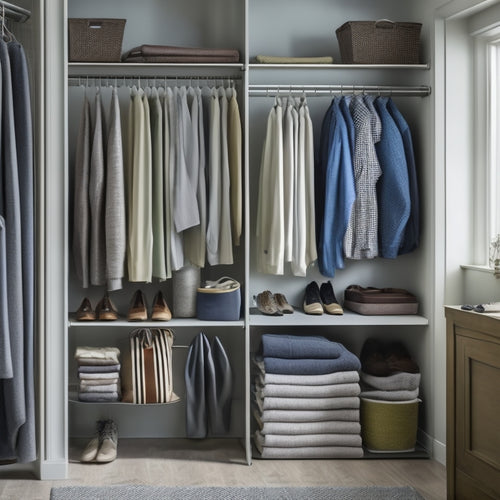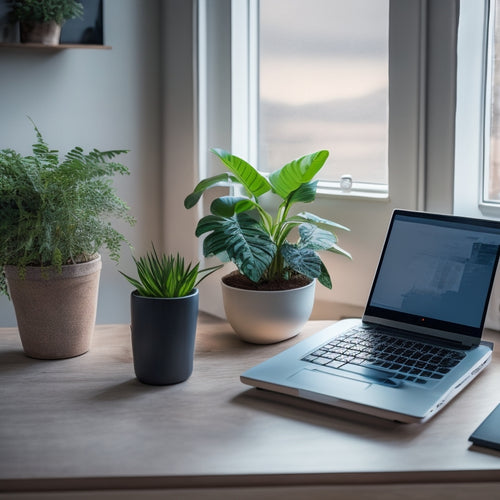
7 Tips to Optimize Your Home Storage Space
Share
You're tired of cluttered closets and disorganized living spaces. To optimize your home storage space, start by tracking your daily habits to identify your needs. Then, purge items you no longer need or use, and sort the rest into categories. Choose multifunctional storage solutions, like versatile furniture with built-in storage, to maximize space. Utilize vertical storage options, like shelving units and hanging organizers, to increase capacity. Designate zones for similar items, and implement a labeling system for easy navigation. Finally, set aside time each week to maintain your newly organized space. Now, get ready to access the full potential of your home's storage space.
Key Takeaways
• Track daily habits and routines to identify storage needs and develop an organizing strategy that suits your lifestyle.
• Purge and sort items into keep, donate/sell, and throw away piles, and prioritize frequently used items for easy access.
• Utilize multifunctional storage solutions like versatile furniture with built-in storage to maximize space and reduce clutter.
• Designate zones for different categories of items and use color coding to organize items within each zone for efficient storage.
• Set aside time each week for maintenance and regular decluttering to prevent storage space from becoming overwhelming.
Assess Your Storage Space Needs
Determine how you live and work in your home to identify areas where storage space is lacking, and start by tracking your daily habits and routines to pinpoint what you need to store. This storage space evaluation will help you develop an organizing strategy tailored to your needs.
Take note of the items you use frequently, as well as those that are seasonal or rarely used. Consider the flow of your daily routine and how you move through your space. Identify areas where clutter tends to accumulate and think about how you can implement space saving solutions to combat this.
As you evaluate your storage space needs, think about your goals for your space. Do you want to free up floor space or reduce clutter? Do you need to create a home office or play area? Answering these questions will help you create a clear vision for your space and inform your organizing strategy.
Purge Clutter Before Organizing
Before you start organizing, you need to tackle the clutter that's taking over your space.
It's crucial to clear out what you no longer need or use, so you can focus on what's truly important.
Clear the Clutter First
You'll be amazed at how much more efficiently you can organize your home storage space once you've purged the clutter that's been accumulating for years.
Before you start searching for storage solutions, take the time to clear out items you no longer need or use. This will give you a fresh slate to work with, making it easier to implement effective organization hacks.
Start by going through each room in your home, sorting items into three piles: keep, donate/sell, and throw away. Be ruthless – if you haven't used it in the past year, it's probably safe to get rid of it.
Some areas to focus on include:
-
Closets: Remove any clothes that no longer fit or are out of style.
-
Kitchen: Get rid of duplicates or broken kitchen gadgets and appliances.
-
Garage/attic: Sort through boxes and bins, keeping only what's truly necessary or useful.
Identify Items to Keep
Now that you've sorted items into three piles, focus on the 'keep' pile and ask yourself which items bring you joy, serve a purpose, or have sentimental value. Be honest with yourself – if you haven't used it in the past year, it's likely taking up valuable space.
Consider sentimental items, such as family heirlooms or photos, that hold emotional significance. These items are worth keeping, but consider digitizing them to free up physical space.
Next, think about hobby supplies, kitchen gadgets, and seasonal decorations that bring you joy or serve a practical purpose. If you're an avid baker, it's likely you'll use that stand mixer again. However, if you haven't touched your knitting needles in years, it might be time to let them go.
Keep items that spark creativity, make you happy, or simplify your daily routine. By narrowing down your 'keep' pile, you'll be left with items that truly add value to your life. This will make it easier to organize and store them in a way that makes sense for your lifestyle.
Sort and Categorize Stuff
With your pared-down 'keep' pile in hand, categorize items into groups based on their function, frequency of use, or storage needs. This vital step in space optimization helps you understand what you have, where it goes, and how to store it efficiently.
To categorize effectively, consider these sorting strategies:
-
Group similar items together: Store all cleaning supplies in one area, and all kitchen utensils in another.
-
Prioritize frequently used items: Place items you use daily in easy-to-reach locations, and less frequently used items towards the back or on higher shelves.
-
Consider storage needs: Designate areas for items that require specific storage conditions, such as temperature-controlled spaces for medications or humidity-controlled areas for musical instruments.
Choose Multifunctional Storage Solutions
When choosing storage solutions, it's essential to think beyond traditional shelving units. Consider options that serve multiple purposes. This approach maximizes space, reduces clutter, and brings a sense of organization to your home.
From floor-to-ceiling storage units to furniture with built-in storage, multifunctional solutions can have a significant impact on your home's functionality.
Maximize Vertical Space
You can triple your storage capacity by choosing multifunctional solutions that make the most of your home's vertical space. This is especially important in small homes or apartments where floor space is limited.
By maximizing your vertical space, you can create more room for storage without sacrificing floor space.
Here are some ways to maximize your vertical space:
-
Install vertical shelving units that go up to the ceiling to store items like books, decorative items, and kitchen utensils.
-
Use hanging organizers like shoe organizers or hanging baskets to store items like cleaning supplies, linens, and accessories.
-
Install wall-mounted racks for items like bikes, tools, or luggage to keep them off the floor and out of the way.
Versatile Furniture Options
Opt for furniture pieces that serve multiple purposes, like ottomans with hidden storage or coffee tables with built-in shelves, to make the most of your floor space. By choosing multifunctional furniture, you'll reduce clutter and create a more organized living area. This approach is especially useful in small homes or apartments where space is limited.
When selecting furniture, look for pieces that offer space saving solutions. For instance, consider a storage bed frame with built-in drawers or a desk with a built-in shelving unit. This type of furniture versatility can help you maximize your space and keep your belongings organized.
Utilize Vertical Storage Options
Maximize your home's storage capacity by capitalizing on often-wasted vertical space. By utilizing vertical storage options, you can create more room for your belongings and keep your floors and surfaces clutter-free. This is especially important in small homes or apartments where every inch counts.
Here are some ways to make the most of your vertical space:
-
Install space saving shelving that goes all the way up to the ceiling to store items like books, decorative items, or out-of-season clothing.
-
Use hanging organizers like shoe organizers or hanging baskets to store items like shoes, bags, or cleaning supplies.
-
Consider investing in stackable storage units or shelves that can be easily assembled and disassembled as needed.
Designate Zones for Similar Items
By categorizing and grouping similar items together, your home's storage space becomes more efficient and easier to navigate. This is because designated zones for similar items allow you to find what you need quickly and effortlessly.
To start, identify categories of items that belong together, such as cleaning supplies, kitchen utensils, or craft materials. Then, assign a specific area or zone for each category.
Within each zone, use color coding to further organize items. For instance, use red bins for cleaning supplies and blue bins for kitchen utensils. This visual system helps you and others quickly identify where items belong.
Grouping similar items together also streamlines your daily routine. You'll no longer waste time searching for misplaced items or dealing with clutter. By designating zones for similar items, you'll create a more organized and functional storage space that makes your life easier.
Implement Labeling and Signage
You can take your organizational system to the next level by labeling each zone and its contents, ensuring that everyone in the household knows exactly what's stored where. This step is fundamental in maintaining order and making the most of your storage space.
By labeling each area, you'll be able to quickly identify what's inside without having to dig through clutter.
To take it a step further, consider implementing a color-coded organization system. This can be as simple as using different colored labels or bins to categorize similar items.
For example:
- Use red labels for important documents and blue labels for household items
- Designate a specific color for each family member's belongings
- Use colored bins to separate seasonal decorations or out-of-season clothing
Create a Maintenance Schedule
Set aside a specific time each week to maintain your newly organized storage space, ensuring it continues to function efficiently and remains clutter-free.
This scheduled organization is essential to prevent clutter from building up again. During this time, conduct regular inspections to identify areas that need attention.
Go through your storage space and remove anything that's no longer needed or useful. Decluttering regularly will help maintain a sense of control and prevent your space from becoming overwhelming.
Frequently Asked Questions
Can I Use Storage Bins With Pests or Rodent Infestations?
When dealing with pest or rodent infestations, you shouldn't use storage bins that can harbor them. Instead, take pest control measures and opt for rodent-proof containers to keep your belongings safe and pest-free.
How Do I Store Items That Require Frequent Temperature Control?
You'll need temperature-regulated storage solutions, like climate-controlled units or thermally insulated containers, to store items requiring frequent temperature control. Organize them by category, label, and date to make sure easy access and best storage organization.
Are There Storage Solutions for Oddly-Shaped or Oversized Items?
You're stuck between a rock and a hard place with those weirdly-shaped items, but fear not! You can design custom shelving or utilize hanging solutions to create a snug fit, keeping them organized and out of the way.
Can I Use Outdoor Storage for Items That Are Not Weather-Resistant?
You can't leave non-weather-resistant items outside, but you can use indoor storage or organization methods, like waterproof bins or creative storage solutions, to keep them safe from the elements.
How Do I Store Valuable or Sensitive Items, Like Important Documents?
You'll want to protect valuable items like important documents from damage and theft. Consider storing them in fireproof safes or secure storage lockers, and use moisture-proof containers for added document protection.
Related Posts
-

Why Double Rods Are Key to Small Closet Organization
By installing double rods, you can instantly double your storage capacity and open up a more organized, clutter-free ...
-

Declutter Your Desk With These Online Tutorials
You're just one organized desk away from boosting your productivity, reducing stress, and achieving a sense of contro...

